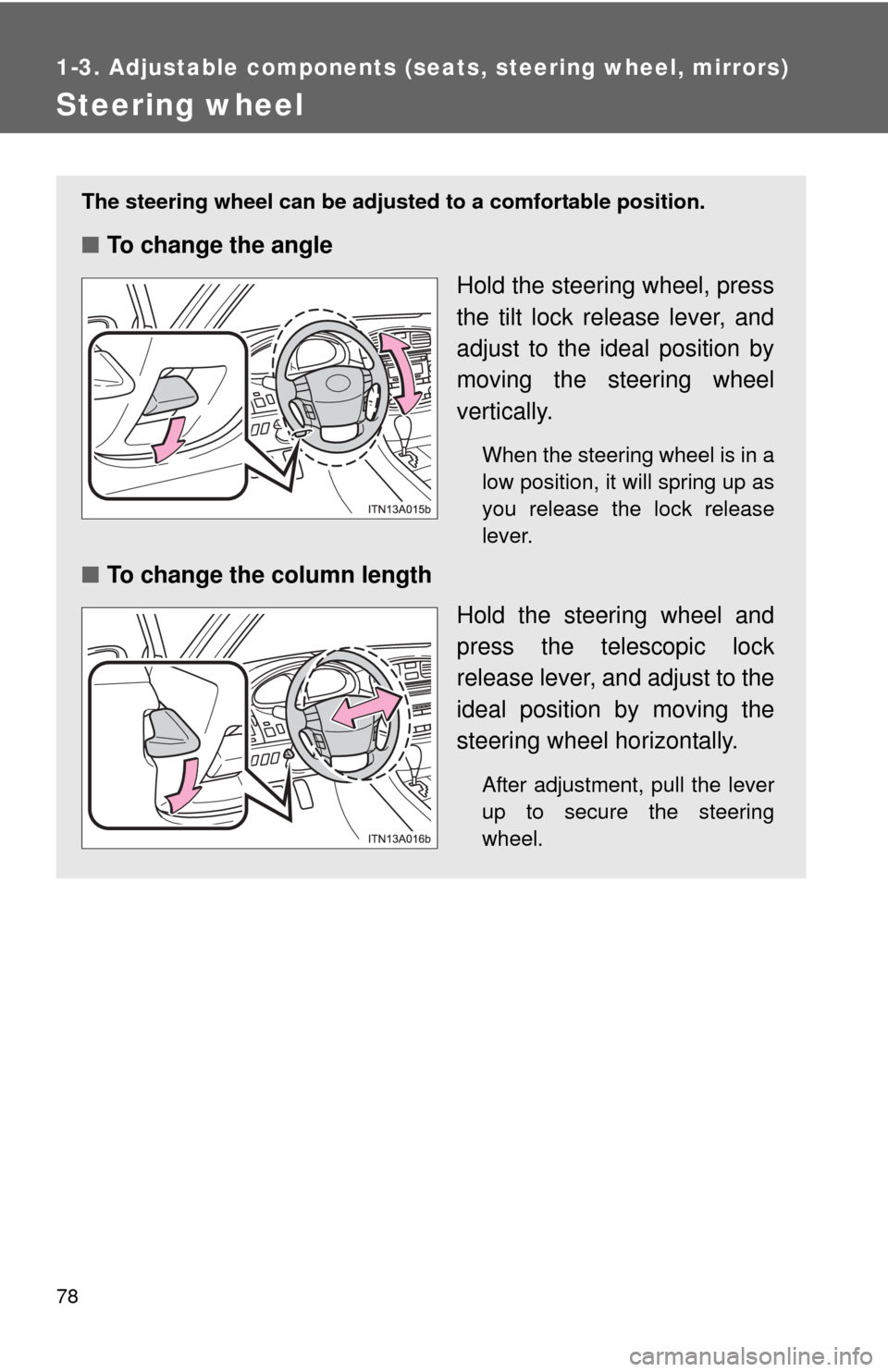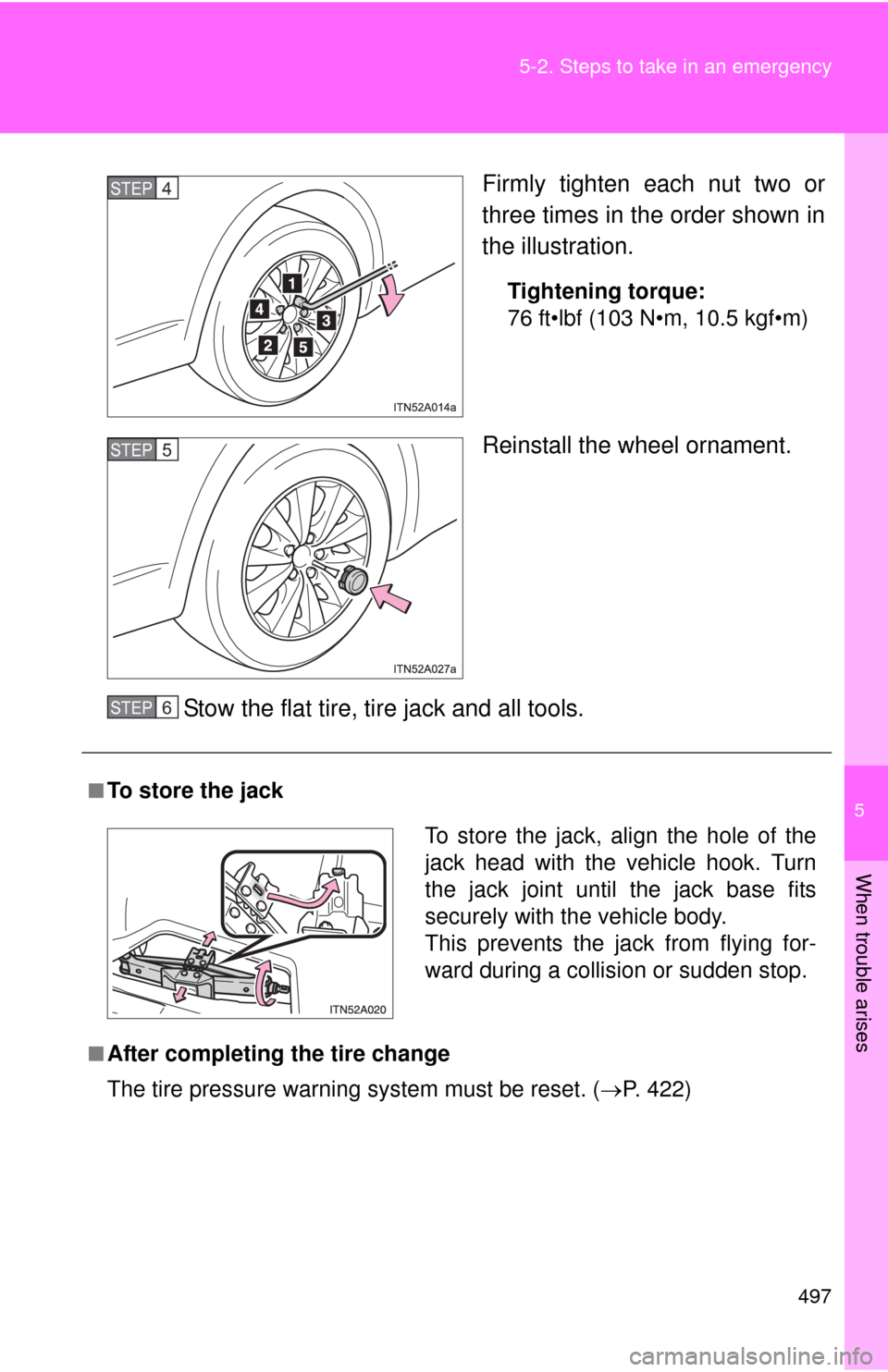change wheel TOYOTA AVALON 2012 XX40 / 4.G Owners Manual
[x] Cancel search | Manufacturer: TOYOTA, Model Year: 2012, Model line: AVALON, Model: TOYOTA AVALON 2012 XX40 / 4.GPages: 580, PDF Size: 9.33 MB
Page 78 of 580

78
1-3. Adjustable components (seats, steering wheel, mirrors)
Steering wheel
The steering wheel can be adjusted to a comfortable position.
■To change the angle
Hold the steering wheel, press
the tilt lock release lever, and
adjust to the ideal position by
moving the steering wheel
vertically.
When the steering wheel is in a
low position, it will spring up as
you release the lock release
lever.
■To change the column length
Hold the steering wheel and
press the telescopic lock
release lever, and adjust to the
ideal position by moving the
steering wheel horizontally.
After adjustment, pull the lever
up to secure the steering
wheel.
Page 113 of 580

113
1-7. Safety information
1
Before driving
CAUTION
■
SRS airbag precautions
Observe the following precautions regarding the airbags.
Failure to do so may cause death or serious injury.
●The driver and all passengers in the vehicle must wear their seat belts
properly.
The SRS airbags are supplemental devices to be used with the seat belts.
● The SRS driver airbag deploys with considerable force, and can cause
death or serious injury especially if the driver is very close to the airbag.
The National Highway Traffic Safety Administration (“NHTSA”) advises:
Since the risk zone for driver airbag is the first 2 - 3 in. (50 - 75 mm) of
inflation, placing yourself 10 in. (250 mm) from your driver airbag provides
you with a clear margin of safety. This distance is measured from the cen-
ter of the steering wheel to your breastbone. If you sit less than 10 in. (250
mm) away now, you can change your driving position in several ways:
• Move your seat to the rear as far as you can while still reaching the
pedals comfortably.
• Slightly recline the back of the seat. Although vehicle designs vary, many drivers can achieve the 10 in.
(250 mm) distance, even with the driver seat all the way forward, sim-
ply by reclining the back of the seat somewhat. If reclining the back of
your seat makes it hard to see the road, raise yourself by using a firm,
non-slippery cushion, or raise the seat if your vehicle has that feature\
.
• If your steering wheel is adjustable, tilt it downward. This points the air- bag toward your chest instead of your head and neck.
The seat should be adjusted as recommended by NHTSA above, while
still maintaining control of the foot pedals, steering wheel, and your view of
the instrument panel controls.
Page 147 of 580

147
2-1. Driving procedures
2
When driving
CAUTION
■
When driving the vehicle
●Do not adjust the position of the steering wheel, the seat, or the inside or
outside rear view mirrors while driving.
Doing so may result in a loss of vehicle control that can cause accidents
that may result in death or serious injury.
● Always check that all passengers’ arms, heads or other parts of their bod-
ies are not outside the vehicle, as this may result in death or serious injury.
● Do not drive in excess of the speed limit. Even if the legal speed limit per-
mits it, do not drive over 85 mph (140 km/h) unless your vehicle has high
speed capability tires. Driving over 85 mph (140 km/h) may result in tire
failure, loss of control and possible injury. Be sure to consult a tire dealer
to determine whether the tires on your vehicle are high-speed capability
tires or not before driving at such speeds.
■ When driving on slippery road surfaces
●Sudden braking, acceleration and steering may cause tire slippage and
reduce your ability to control the vehicle, resulting in an accident.
● Sudden changes in engine speed, such as engine braking caused by up-
shifting or down-shifting, may cause the vehicle to skid, resulting in an
accident.
● After driving through a puddle, lightly depress the brake pedal to make
sure that the brakes are functioning properly. Wet brake pads may prevent
the brakes from functioning properly. If the brakes on only one side are wet
and not functioning properly, steering control may be affected, resulting in
an accident.
Page 205 of 580

205
2-4. Using other
driving systems
2
When driving
CAUTION
■When using the rear view monitor system
Observe the following precautions to avoid an accident that could result in
death or serious injuries.
●Never depend solely on the monitor system when reversing.
● Always check visually and with the mirrors to confirm your intended path is
clear.
● Depicted distances between objects and flat surfaces differ from actual
distances.
● Do not use the system if the trunk is not completely closed.
● Never back up while looking only at the screen. The image on the screen
is different from actual conditions. Depicted distances between objects
and flat surfaces will differ from actual distance. If you back up while look-
ing only at the screen, you may hit a vehicle, a person or an object. When
backing up, be sure to check behind and all around the vehicle visually
and with mirrors before proceeding.
● Always check the vehicle surroundi ng area, because the guide lines are
ancillary.
● The guide lines are ancillary lines and does not change even if the steer-
ing wheel is turned.
● Depicted distances between objects and flat surfaces differ from actual
distances.
Page 489 of 580

5
When trouble arises
489
5-2. Steps to take in an emergency
CAUTION
■If the tire pressure warning light comes on
Be sure to observe the following precautions. Failure to do so could
cause loss of vehicle control and result in death or serious injury.
●Stop your vehicle in a safe place as
soon as possible. Adjust the tire
inflation pressure immediately.
●If the tire pressure warning light comes on even after tire inflation pres-
sure adjustment, it is pr obable that you have a flat tire. Check the tires.
If the tire is flat, change to the spare tire and have the flat tire repaired
by the nearest Toyota dealer.
●Avoid abrupt maneuvering and braking. If the vehicle tires deteriorate,
you could lose control of the steering wheel or the brakes.
■If a blowout or sudden air leakage should occur
The tire pressure warning syste m may not activate immediately.
■Maintenance of the tires
Each tire, including the spare (if provided), should be checked monthly
when cold and inflated to the inflation pressure recommended by the
vehicle manufacturer on the vehicle placard or tire inflation pressure
label (tire and load information label). (If your vehicle has tires of a differ-
ent size than the size indicated on the vehicle placard or tire inflation
pressure label [tire and load information label], you should determine the
proper tire inflation pr essure for those tires.)
As an added safety feature, your vehicle has been equipped with a tire
pressure monitoring system (TPMS-ti re pressure warning system) that
illuminates a low tire pressure telltal e (tire pressure warning light) when
one or more of your tires is significantly under-inflated. Accordingly,
when the low tire pressure telltale (tire pre ssure warning light) illumi-
nates, you should stop and check your tires as soon as possible, and
inflate them to the proper pressure. Driving on a significantly under-
inflated tire causes the tire to overheat and can lead to tire failure.
Under-inflation also reduces fuel effi ciency and tire tread life, and may
affect the vehicle’s handling and stopping ability.
Page 497 of 580

5
When trouble arises
497
5-2. Steps to take in an emergency
Firmly tighten each nut two or
three times in the order shown in
the illustration.
Tightening torque:
76 ft•lbf (103 N•m, 10.5 kgf•m)
Reinstall the wheel ornament.
Stow the flat tire, tire jack and all tools.
STEP4
STEP5
■To store the jack
■After completing the tire change
The tire pressure warning system must be reset. (P. 422)
STEP6
To store the jack, align the hole of the
jack head with the vehicle hook. Turn
the jack joint until the jack base fits
securely with the vehicle body.
This prevents the jack from flying for-
ward during a collisio n or sudden stop.
Page 569 of 580

569
Alphabetical index
Alphabetical index
A/C ............................................ 228
ABS........................................... 207
Air conditioning systemAir conditioning filter ............. 437
Automatic air conditioning
system................................ 228
Steering switches ................. 236
Airbags Airbag operating conditions .. 109
Airbag precautions for your child.................................... 113
Airbag warning light .............. 481
Curtain shield airbag precautions ........................ 116
Front passenger occupant classification system .......... 119
General airbag precautions .. 113
Locations of airbags ............. 106
Modification and disposal of airbags ............................... 118
Side airbag precautions........ 113
Side and curtain shield airbags operating conditions ........... 109
SRS airbags ......................... 106
Alarm .......................................... 99
Antenna .................................... 248
Anti-lock brake system ........... 207
Armrest .................................... 365
Ashtrays ................................... 360
Audio input .............................. 285
Audio system
Antenna ................................ 248
Audio input ........................... 285
AUX port ............................... 285
CD player/changer ............... 251
iPod ...................................... 267
MP3/WMA disc ..................... 259
Optimal use .......................... 282
Portable music player ........... 285
Radio .................................... 243
Steering wheel audio switches ............................. 286
USB memory ........................ 274 Automatic headlight leveling
system ....................................181
Automatic light control system ....................................178
Automatic transmission Automatic transmission .........161
If the shift lever cannot be shifted from P......................503
S mode ..................................163
AUX port ...................................285
Back-up lights
Wattage .................................527
Battery Checking ...............................417
If the vehicle battery is
discharged ..........................508
Preparing and checking
before winter .......................219
Bluetooth
® audio......................289
Bluetooth® phone ....................308
Brake Fluid ......................................414
Parking brake ........................167
Brake assist ..............................207
Break-in tips .............................144
Care Exterior ..................................386
Interior ...................................389
Seat belts ..............................390
Cargo capacity .........................212
CD player/changer ...................251
Chains .......................................221
Child-protectors .........................49
A
B
C